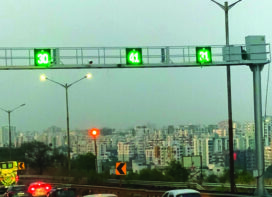 A study on the use of Variable Message Signs for getting traffic information was carried out in Kolkata by two Associate Professors of IIT. They opine that there is a need to revisit the taxi fare structure in Kolkata city as the present taxi fare policy is considerably skewed to the length (distance) of the journey route rather than journey time, resulting in taxi users choosing shorter but congested routes.
A study on the use of Variable Message Signs for getting traffic information was carried out in Kolkata by two Associate Professors of IIT. They opine that there is a need to revisit the taxi fare structure in Kolkata city as the present taxi fare policy is considerably skewed to the length (distance) of the journey route rather than journey time, resulting in taxi users choosing shorter but congested routes.
Traffic congestion in urban areas is a major concern of transportation professionals. It is temporal (i.e. level of congestion changes over time) in behaviour and spatial (i.e. intensity of congestion changes over geographic location) in nature. Therefore, there has been a growing trend of using real-time traffic information as an instrument for influencing route choice behaviour of motorists for better management of congestion on urban roads both temporally and spatially. Among various types of traffic information systems, the variable message sign (VMS) board is recognised as the most cost-effective advanced traveller information system. The VMS board is used for displaying non-personalised real-time traffic information which is commonly operated by traffic controllers. Although several studies have been reported on VMS based traffic information in developed countries, there is limited information available on the impact and effectiveness of such traffic information in the Indian context. This article reports an investigation on VMS based traffic information in the Indian context and highlights some findings from the study.
Two key aspects of VMS based traffic information are content of information and its format. In this study, two types of VMS based traffic information (called as traffic information TI-I and TI-II) were examined. In type TI-I, instantaneous travel time alone (i.e. a single item in quantitative format) was considered as traffic information; whereas in traffic
information type TI-II, an enhanced version of traffic information, considering both instantaneous travel time and its variation level (i.e. a combination of both quantitative and qualitative format), was considered. A VMS board is assumed to display traffic information at a junction of two traffic corridors connecting two catchments. Typical examples of two types of VMS based traffic information are shown in Figure-1 and Figure-2.
 Figure 1: An Example of VMS Board Displaying Instantaneous Travel time as Traffic Information.
Figure 1: An Example of VMS Board Displaying Instantaneous Travel time as Traffic Information.
 Figure 2: An Example of VMS Board Displaying both Instantaneous Travel time and its Variation Level as Traffic Information.
Figure 2: An Example of VMS Board Displaying both Instantaneous Travel time and its Variation Level as Traffic Information.
The work was carried out with reference to two distinct and competitive traffic corridors in the Kolkata Metro City (Figure 3). These corridors connect two important catchments of the city which are known as Park Circus and Esplanade/Dalhousie. While the Esplanade/Dalhousie is the Central Business District (CBD) of the city, traffic from different parts of the downtown go to the CBD en-route Park Circus. Substantial traffic movements are observed on a daily basis between these two catchments. The study corridors connecting these catchments are called Park Street Corridor (PS) and Flyover Corridor (FO).
The length of PS corridor is 3.4km and it has six signalised intersections whereas the length of FO corridor is 5.0km and it has four signalised intersections. Although the PS corridor is shorter, it often becomes congested due to the limited capacity of the corridor. On the other hand, the FO corridor includes a 2.1km long flyover in addition with other high capacity road links. Therefore, FO corridor normally remains congestion-free and offers higher speed. Present traffic management strategies in Kolkata as such do not include the use of real-time traffic information for management of traffic congestion in the city. Therefore, motorists select the route based on their perception and experience of traffic conditions along these corridors. Once the real-time traffic information is provided via VMS, it is expected to influence the route choice behaviour of motorists which will result into different traffic volumes and travel times in the two traffic corridors.
The impact and effectiveness of traffic information greatly depends on the behaviour of motorists. Therefore, the investigation on VMS was carried out in two stages. In the first stage, the impact of traffic information was captured by investigating the behaviour of the motorists in choosing the route. For this purpose, two types of corridor choice behavioural data were collected from motorists: stated preference (SP) data and revealed preference (RP) data. While the present route choice behaviour under no-traffic-information scenario was captured in terms of RP data, the route choice behaviour under the two traffic-information scenarios was captured with the help of SP data. SP data was analysed by developing various econometric models to calculate the valuation of attributes of traffic information by motorists. This was instrumental in understanding if travel time information displayed as VMS is considered as beneficial by motorists. Thus, both SP and RP data were used to develop the route choice models under two traffic information scenarios.
The work was carried out primarily considering mainly the two types of motorists using the study corridors – private cars and taxis. In the second stage, the effect of traffic information on traffic flow and as a result, the possible benefits for motorists were evaluated using traffic assignment models under a dynamic paradigm. As the corridor choice behaviour of the motorists is expected to be influenced by traffic information from one time to another, there is a possible temporal variation in the pattern of traffic movements on the two alternative corridors. Such temporal pattern of variation in traffic movement was simulated by developing traffic assignment models under a dynamic paradigm (also called as dynamic traffic assignment DTA). Two types of DTA models were developed for representing traffic movement under traffic-information and no-traffic-information scenarios.
 The DTA models developed are specific to the study corridors. The effect of traffic information in terms of decongesting the PS corridor and bringing overall saving in the travelling time of vehicles was investigated by the application of DTA models. In order to understand the role of overall traffic volumes in the context of VMS, several DTA runs were taken considering 70%, 100% and 130% of the present traffic volumes. This was helpful to understand the likely variation of benefits, if any, that would accrue from providing VMS at these traffic volume levels.
The DTA models developed are specific to the study corridors. The effect of traffic information in terms of decongesting the PS corridor and bringing overall saving in the travelling time of vehicles was investigated by the application of DTA models. In order to understand the role of overall traffic volumes in the context of VMS, several DTA runs were taken considering 70%, 100% and 130% of the present traffic volumes. This was helpful to understand the likely variation of benefits, if any, that would accrue from providing VMS at these traffic volume levels.
Figure 3: A Location Map for the Study Area and Traffic Corridors.
A detailed examination of the impact of traffic information on the travel behaviour of private car and taxi users has been reported in Basu and Maitra (2010a), while the effectiveness of providing two types of traffic information on traffic movement along the study corridors has been reported in Basu and Maitra (2010b). Some major findings from the study are:
- Both types of traffic information (i.e. TI-I and TI-II) are considered as beneficial by private car and taxi drivers. A lower variation of travel time in TI-II is also considered as beneficial by the two categories of motorists. The study also reveals that TI-I and TI-II are perceived distinctly and differently by private car and taxi drivers.
- The corridor choice of private car and taxi motorists is expected to be different with and without traffic information. Also, the corridor choice behaviour of each category of motorists is expected to be different with the two types of VMS based traffic information.
- In general, private car motorists are likely to be more influenced to take shorter travel time route under traffic information. However, when the levels of variation of travel time on alternative traffic corridors are distinctly different, the influence on taxi drivers under traffic information TI-II is expected to be more than private car drivers.
- The percentage di
 stribution of journey time (Figure-4) along the congested PS corridor indicates that traffic information is expected to be instrumental for decongesting the traditionally used shorter length of traffic corridor. A significant percentage of traffic is expected to travel with considerably less journey time. The figure also indicates that under traffic information TI-II, a further reduction in journey time can be expected for some percentage of the total traffic movement.
stribution of journey time (Figure-4) along the congested PS corridor indicates that traffic information is expected to be instrumental for decongesting the traditionally used shorter length of traffic corridor. A significant percentage of traffic is expected to travel with considerably less journey time. The figure also indicates that under traffic information TI-II, a further reduction in journey time can be expected for some percentage of the total traffic movement. - With traffic information, significantly higher route split is expected for private cars in favour of the corridor with less journey time (i.e. FO corridor). However, this might bring back some taxis to the corridor with short distance (i.e. PS corridor).
- In the present case study, both types of traffic information is expected to be more beneficial in spatial and temporal management of traffic congestion at higher traffic volume levels. The study also indicates that for a successful management of traffic congestion using traffic information, there is a need to revisit the taxi fare structure in the Kolkata city, as the present taxi fare policy is found to be considerably skewed to the length (distance) of the journey route rather than journey time, resulting in taxi users choosing shorter but congested routes.
 Associate Professor
Civil Engineering, IIT, Kharagpur
Associate Professor
Civil Engineering, IIT, Kharagpur
(Dr Maitra’s research interests include congestion modelling and management, public transport system, travel demand modelling, road safety and transport policy)
Dr Debasis Basu Assistant Professor
School of Infrastructure, IIT, Bhubaneswar
Assistant Professor
School of Infrastructure, IIT, Bhubaneswar
(Dr Debasis Basu’s research interests include temporal congestion management by means of traffic information, improvement of the quality of public transportation service and micro-simulation assisted travel demand modelling)
 TrafficInfraTech Magazine Linking People Places & Progress
TrafficInfraTech Magazine Linking People Places & Progress


